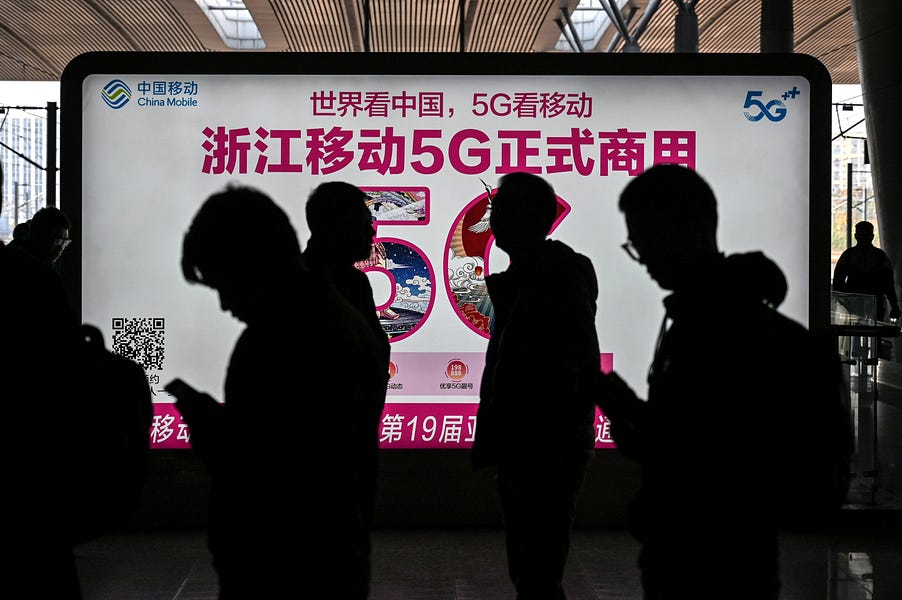Dear reader,
I’ve spent the past several days reading up on 5G wireless technology and its implications for the “Great Power Competition” (GPC) between the U.S. and China. On Tuesday, the U.K. government decided, against the wishes of the U.S., to allow China to play a role in developing its 5G networks. That’s a big deal.
While this may not have been a full-fledged battle in the GPC era, it was a skirmish. The U.S. and the Trump administration lost. The British will reportedly limit the market share of Huawei, one of China’s main manufacturers, and also restrict its products to industries that aren’t security sensitive. But still, Huawei is being allowed into the U.K.’s burgeoning 5G networks despite some dramatic warnings from U.S. officials and elected representatives.
“Can you imagine a situation where, in the ’80s, Ronald Reagan and Margaret Thatcher have a conversation and they say, ‘You know, I think we should have the KGB come and build all of our telecommunications and computer network systems because they’re offering a great discount’,” President Trump’s deputy national security adviser, Matthew Pottinger, recently said.
Pottinger’s warning was echoed by Republican Reps. Mike Gallagher and Liz Cheney. Cheney blasted Boris Johnson, the new prime minister of the U.K., for choosing China’s “surveillance state over the special relationship.”
The U.S. warned the British that allowing Huawei to gain traction in its 5G networks may compromise intelligence sharing across the “Five Eyes” nations. Australia, Canada, New Zealand, the United Kingdom, and the United States comprise the “Five Eyes” network, which allows for special coordination on extremely sensitive signals and other intelligence.
The economic appeal of 5G—and Huawei’s equipment—was so strong that Johnson concluded the security risks are worth it. But the economic and security issues here are closely linked, inseparable really.
Before I delve in, I’d like to offer a warning of sorts. I am not a techie. At all. I’m closer to a walking, talking EMP (electromagnetic pulse) device than an actual expert on technology.
When I told my wife that I planned to write about computers and 5G wireless this week she immediately looked confused. “Why? You…know that isn’t really your thing,” she said. She’s right. It’s been our running joke for years—computers and phones tend to do the opposite of what I want them to do. I can’t tell you how many times I’ve heard someone in technical support say something like, “I’ve never seen that before.” It’s a minor miracle that my computer wasn’t infected with a virus while writing this.
All of which is to say that if you are technologically inclined, then forgive my amateurish attempt to make sense of 5G. I’m not going to pretend to understand the technical aspects, but I’ve tried to distill the broader economic and national security issues surrounding its emergence.
What is 5G?
You’ve probably seen multiple wireless carriers advertising their new and improved 5G network. Not long ago it was all about 4G, now it’s 5G. Each of the wireless companies has the best coverage, or the fastest, or they are No. 1 in some category we are supposed to care about. It’s all very confusing. But they have color maps, and that’s supposed to make us want it. 5G is the best and we are Americans, so we want the best! Or the fastest, or the best coverage, or something.
What, exactly, is 5G? Well, for starters, it isn’t one thing. The “G” obviously stands for generation, as in a generation of wireless technology. As with any human generation, there is variability across the population. But there are some commonalities, too. The global mobile industry first announced its standard for 5G NR (“New Radio”) in December 2017 and then tinkered with that standard in the months that followed. 5G NR is just one of many acronyms the industry uses. It’s somewhat maddening. By the time I was finished reading several papers on 5G I was pining for my days studying Latin.
Just as humans evolve across generations, so, too, does wireless technology. I don’t want to press the comparison too far, however, because while there have been relatively minor changes in the human genome that are perceptible as far back as anyone can remember in living history, wireless technology is evolving at a breakneck pace right before our eyes.
Beginning around 1980, 1G was the technological standard for analog cell phones—those big, clunky devices that we all laugh about now, but status-seekers and social climbers flashed throughout the 1980s. 2G, introduced about a decade later in the early 1990s, brought with it the era of digital cellular technology, including data services. We could now text one another. 3G was a much faster digital architecture. Apple introduced the first iPhone in June 2007, taking advantage of much improved 3G networks, and thus began the era of smart phones. 3G allowed software developers to offer many of the apps we’ve come to use in our daily lives.
We are living in a predominantly 4G world. Wireless carriers began pushing their 4G devices in 2010 and 2011, though there was some sleight-of-hand involved as highly evolved 3G technologies could be considered 4G for marketing purposes at first. (Again, the various digital Gs form a continuum, as one evolves into the next.) 4G technology (LTE) allowed for even more data-intense apps, such as Snapchat and Uber, to become popular. 4G meant data could be shared at a much faster rate.
If you believe the hype, 5G will mark a sea change—a leap forward that goes well beyond 4G. It will speed up data transfers, enhance storage capacity, increase security and reduce latency (that is, the time it takes for a computer to do what you tell it to do). We will witness the era of driverless cars and trucks, which are already being tested. Artificial intelligence will transform entire industries, ranging from food and beverage to health care. 5G will lead to more sophisticated weaponry, including hypersonic ones.
And there’s something called the “Internet of Things,” which basically sounds like the beginning of a horror movie. It’s the common digital architecture that connects household appliances and other inanimate objects to computers, databases, and devices in one big web. The movie the machines will make about this in the year 2050, when we are all dead, will begin: “And then the microwaves had enough of their masters.” I’m kidding, obviously. (But not really. Come to think of it, my EMP deficiency may actually be a Neo-style gift. Stay by my side, and we’ll stop the machines.)
To think of it in terms of a comic book: the evolution from 1G to 5G is akin to us mere Homo sapiens giving way to mutants in less than two generations. You and I are 1G. Charles Xavier and his X-Men are 5G.
While all of the major wireless carriers have launched 5G here in the states, you are probably still using 4G technology. My wife and I recently upgraded to Apple’s iPhone 11 Pro Max, but it’s still 4G. I didn’t realize this until I started doing research for this newsletter. We live fairly close to New York City—no 5G yet. Naturally, my wife is doing all sorts of neat tricks with the phone’s three cameras, while I’m happy to report that I’ve almost figured out how to answer all calls. (This, sadly, is not a joke. For some reason, the phone sometimes fights me on this. Don’t judge me.)
Bottom line: For all of the hoopla surrounding 5G, it is going to take some time for that technology to proliferate. Still, the 5G future will be here before you know it. The next wave of 5G apps is expected sometime in 2021 or 2022.
Why does 5G competition matter for Americans?
Americans should be concerned about China’s aggressive expansionist plans for 5G. Here are some reasons why.
As explained in this excellent report published by the Defense Innovation Board last year, there are very strong first-mover advantages for countries and companies that set up shop early. Those advantages include significant economic growth and new jobs, as well as the ability to set standards for an entire ecosystem of technologies, thereby making the rest of the world follow them.
Europe was ahead of the pack in the 2G era and Japan led the early 3G world. It took years for the U.S. to catch up. When the U.S. finally did—after investing significant time and resources—Americans dominated 4G.
According to estimates prepared by Recon Analytics, America’s global 4G leadership accounted for nearly $100 billion in GDP growth by 2016, approximately $125 billion in additional revenue for American companies and another $40 billion in additional app store revenue. In addition, the “launch of 4G in the US increased total wireless-related jobs by 84% from 2011 to 2014.”
That’s real money and those are real jobs for Americans.
But the U.S. isn’t leading the 5G field. China is.
The Chinese have already rolled out 5G capacity across 40 to 50 cities, and they’re looking to add more shortly. The Chinese may be poised to accrue the economic benefits of first-mover status, and also get to shape the playing field itself. That wouldn’t be such a big problem if China behaved more like modern-day Germany or Japan—two countries that were early victors in the 2G and 3G eras, respectively. But China is very different. The Chinese are building an internal surveillance state, while also seeking to undermine America’s global leadership across the board.
“Great Power Competition” will take place on a number of fronts. Not only is 5G a key battlespace on its own, it touches many of the others as well.
What is China’s plan?
China’s plan for 5G dominance is built on two broad pillars, one domestic and the other foreign.
Domestically, the Chinese government has taken steps to ensure that its 5G ecosystem is largely standalone—that is, China’s 5G won’t depend on outside help or technology. This is part of the government’s “Made in China 2025” (MIC 2025) plan.
In a 2017 report, the U.S. Chamber of Commerce summarized what MIC 2025 means for wireless communication equipment and related technologies, the next generation of the Internet, as well as high performance computers and servers. Within China’s borders, Chinese firms are on a path to have the dominant market shares (not 100 percent, but upward of 80 percent) in each of the key 5G-related areas. This limits the potential sales for foreign competitors in China’s massive marketplace. China has also required foreign cellular providers to enter into joint ventures, thereby ensuring that the government remains in the driver’s seat.
Months before the first 5G standard was finalized in December 2017, the equity research team at Jefferies estimated that China’s three main telecommunications companies—China Mobile, China Unicom, and China Telecom—were going to spend upward of $180 billion on 5G infrastructure over seven years. This sum dwarfs China’s investment in 4G, an indication of the importance Xi Jinping’s regime is placing on the matter. And as the South China Morning Postfirst reported, it also dwarfs the amount Japan, China’s main Asian rival, is anticipated to spend on 5G.
As of mid-2019, according to the Chinese government, there were 1.24 billion users on 4G networks inside the country. Even though 4G-related sales have been declining, that gives you a sense of the size of the market. The U.S. consumer market is far, far smaller. Some analysts are predicting a surge in 5G-related sales in China this year.
Because China controls a massive market of its own, it hopes to tilt the 5G playing field in its direction right from the go. Companies around the world want access to China’s marketplaces, but they’ll have to play by China’s 5G rules to get it.
In terms of foreign sales, Huawei and ZTE are the two main Chinese companies seeking to gain market share. Their smartphones aren’t popular in the U.S., and the Trump administration has taken steps to restrict the sale of other Chinese equipment. But the two Chinese companies have significant sales in Europe and elsewhere.
Huawei bragged last year that two-thirds of 5G networks outside of China use its equipment, either entirely or in part. The Chinese companies provide low cost solutions of reasonable to high quality, making it difficult for even America’s staunchest allies to turn down. When Huawei isn’t wooing customers with lower prices, the company allegedly uses other tactics. Randall Stephenson, the cief executive of AT&T Inc., warned last year that Huawei is using sales of 4G related technologies to lock in customers. “If you have deployed Huawei as your 4G network, Huawei is not allowing interoperability to 5G — meaning if you are 4G, you are stuck with Huawei for 5G,” Stephenson claimed.
I noted above that 5G isn’t one thing. The Defense Innovation Board report points to an important explanation for why this is the case—and it is crucial for understanding the competition between the U.S. and China.
Basically, there are two main ways you can deploy 5G technologies across the cellular spectrum. Companies can use what’s known as the “sub-6 mid-band” spectrum, or “mmWave.” As the name implies, “sub-6” refers to frequency bands that are lower than 6 Ghz on the radio spectrum, while “mmWave” refers to a much higher range going up to 300 Ghz.
Both “sub-6” and “mmWave” have their advantages and disadvantages. Some leading American companies argue (quite logically) that “mmWave’s” faster speeds are necessary to reap the full benefits of 5G. But there are problems. For starters, “mmWaves” are more easily blocked—buildings, trees, and even the human body can get in the way. Right now, you have to be in an open-air area like a sports stadium to make it truly work. This means that the U.S. will have to spend considerable sums of money to build a 5G infrastructure that relies on “mmWave.”
Meanwhile, “sub-6” waves are much easier to send and receive over greater distances. The infrastructure is already in place around the world, as 4G and other lesser technologies are already using it. The Defense Innovation Board pointed to yet another problem: The U.S. federal government controls “large swaths of the sub-6 bands,” mainly for the military, so they are “not available for civil/commercial use.” This means that private industry inside the U.S. cannot aggressively pursue a “sub-6” strategy to counter China’s designs.
While it looks as though 5G will end up relying on both “sub-6” and “mmWave,” the Chinese enjoy a major structural advantage in that they are not limited. They can push ahead with 5G technologies in the “sub-6” spectrum without worrying about the unique hindrances faced by American companies.
This allows China to gobble up market share in other foreign countries, which also do not have restrictions on their “sub-6” spectrum, while the U.S. is left to hope that “mmWave” capabilities improve faster than expected. The Defense Innovation Board also recommended that the U.S. government open access to the “sub-6” band, so that private enterprise can do its thing.
Significant security liabilities.
The discussion above focuses mainly on the economics of 5G competition. Of course, there are major security liabilities. The Defense Department is worried that as it relies on more commercial technology, Chinese-made components will compromise its supply chain. This is especially concerning if much of the rest of the world follows China in the “sub-6 5G ecosystem,” which the U.S. isn’t well-positioned to lead, let alone control. There are ongoing concerns about poor software design, or outright malfeasance—with the Chinese hiding backdoors for espionage and cybertheft.
The threat of backdoors extends to 5G devices, including cell phones, which are major sellers overseas. “Evidence of backdoors or security vulnerabilities have been discovered in a variety of devices globally,” the Defense Innovation Board’s report reads. “Many of these seem to be related to requirements from the Chinese intelligence community pressuring companies to exfiltrate information about domestic users.”
Such backdoors have been found in handsets and camera software. The Chinese government wants such capabilities to spy on its own people, but there’s nothing to stop Chinese intelligence from repurposing these traps once they are sold around the globe.
These are just some of the reasons the Trump administration implored Boris Johnson to keep Huawei out. He let them in anyway. The fact that U.S. diplomacy failed here raises serious questions about the effectiveness of the State Department. Johnson’s decision will have major implications for the “special relationship” between the U.S. and the U.K. and, undoubtedly, for the future of 5G.
Photograph by Hector Retamal/AFP via Getty Images.






Please note that we at The Dispatch hold ourselves, our work, and our commenters to a higher standard than other places on the internet. We welcome comments that foster genuine debate or discussion—including comments critical of us or our work—but responses that include ad hominem attacks on fellow Dispatch members or are intended to stoke fear and anger may be moderated.
You are currently using a limited time guest pass and do not have access to commenting. Consider subscribing to join the conversation.
With your membership, you only have the ability to comment on The Morning Dispatch articles. Consider upgrading to join the conversation everywhere.